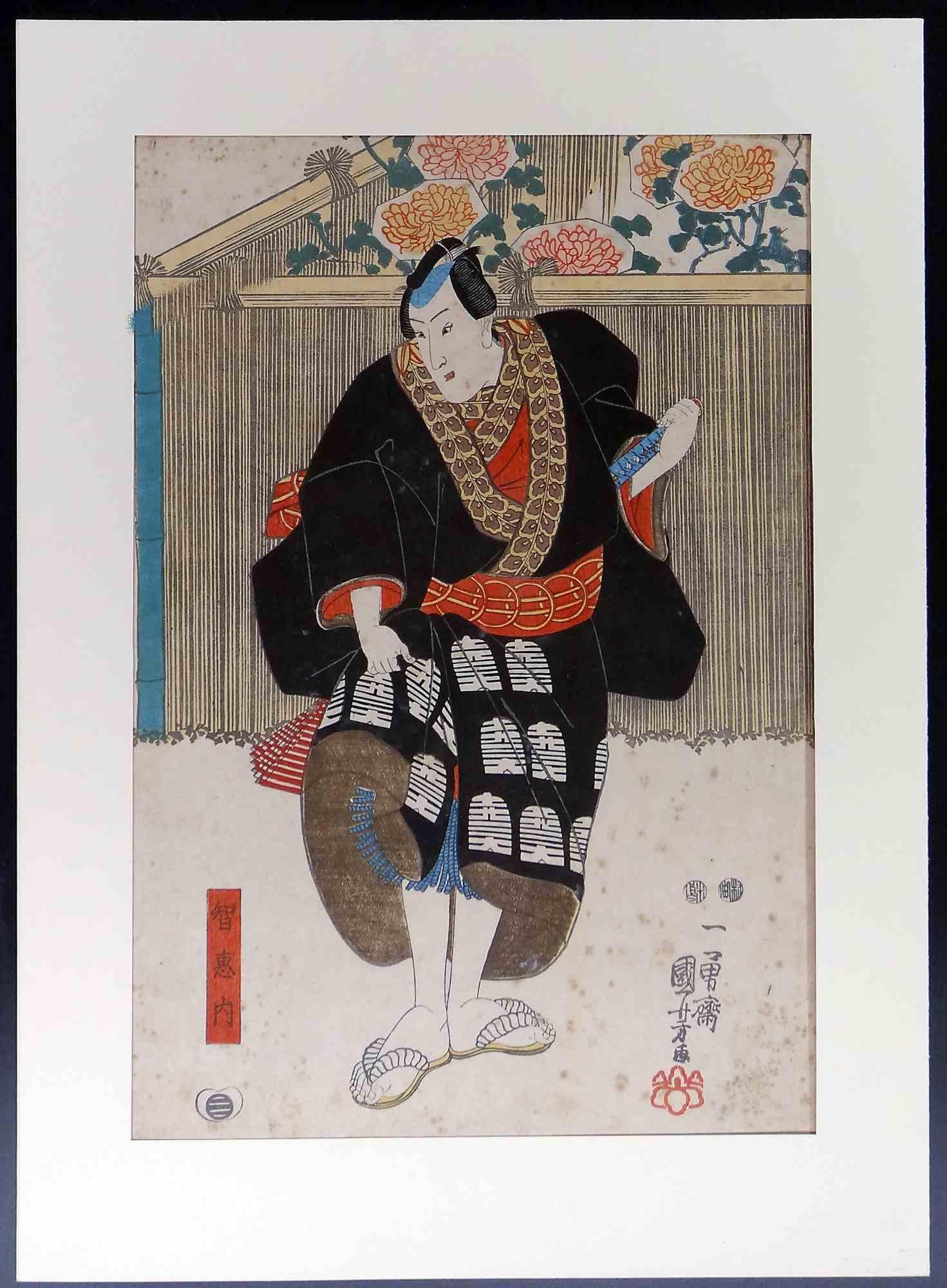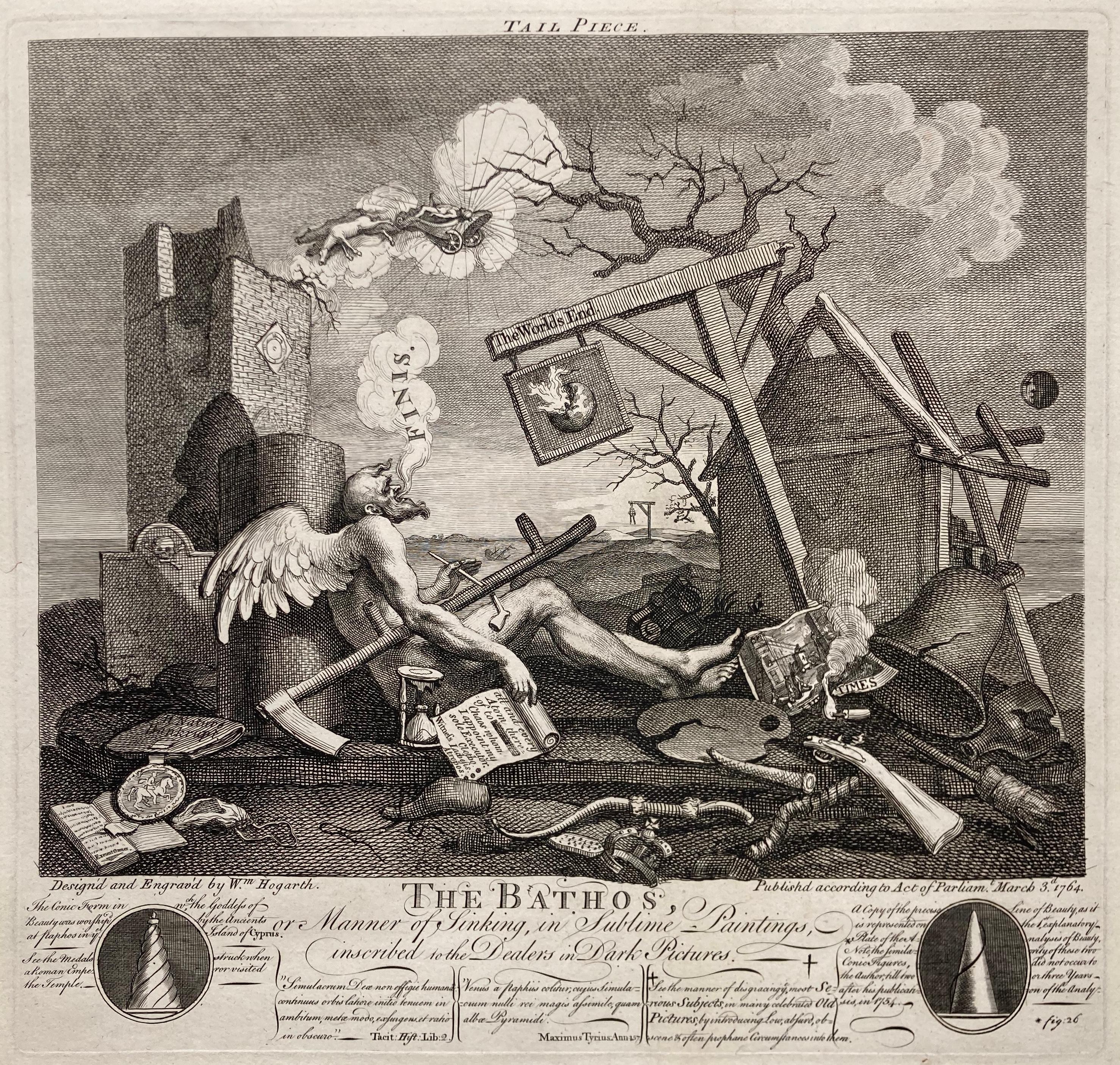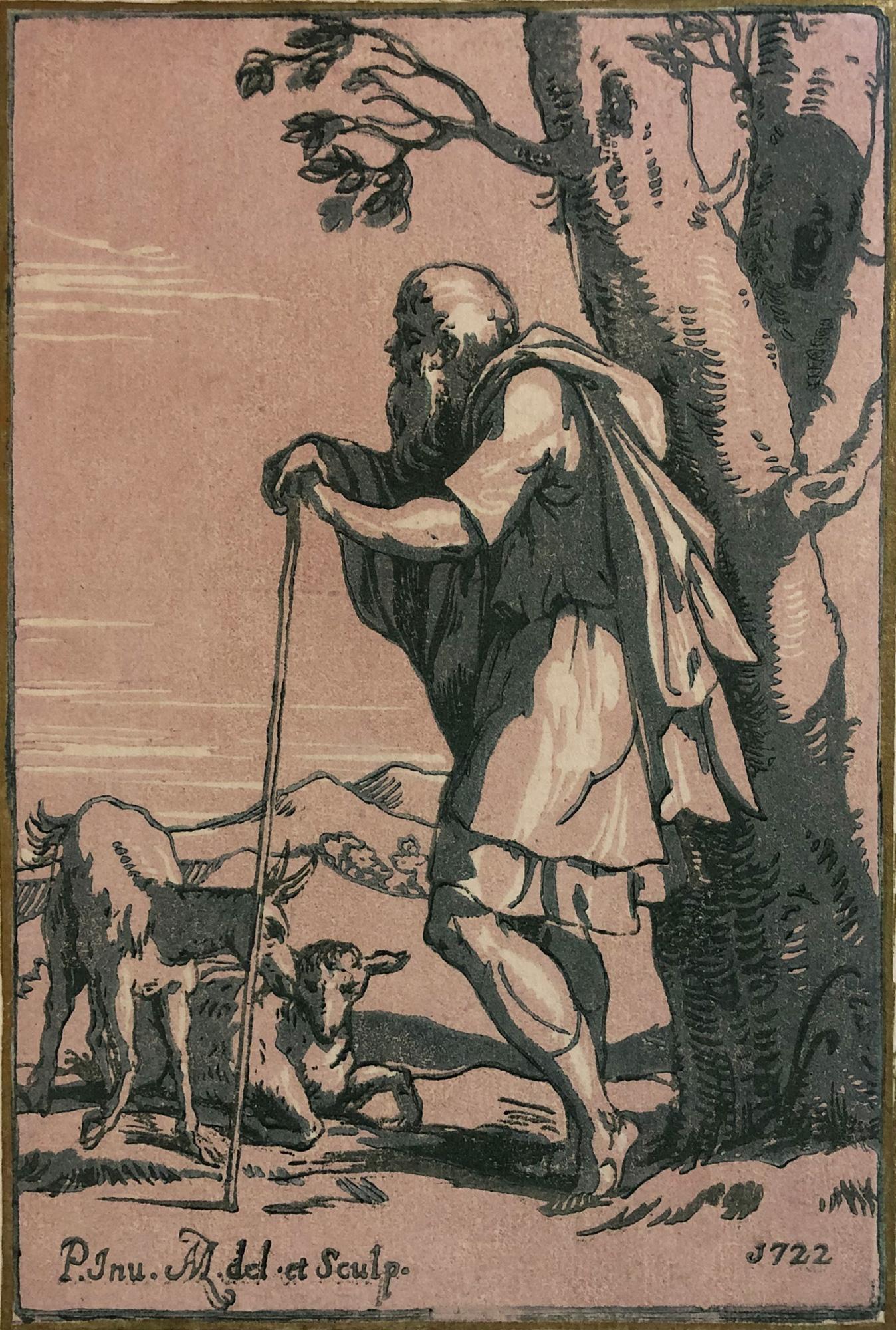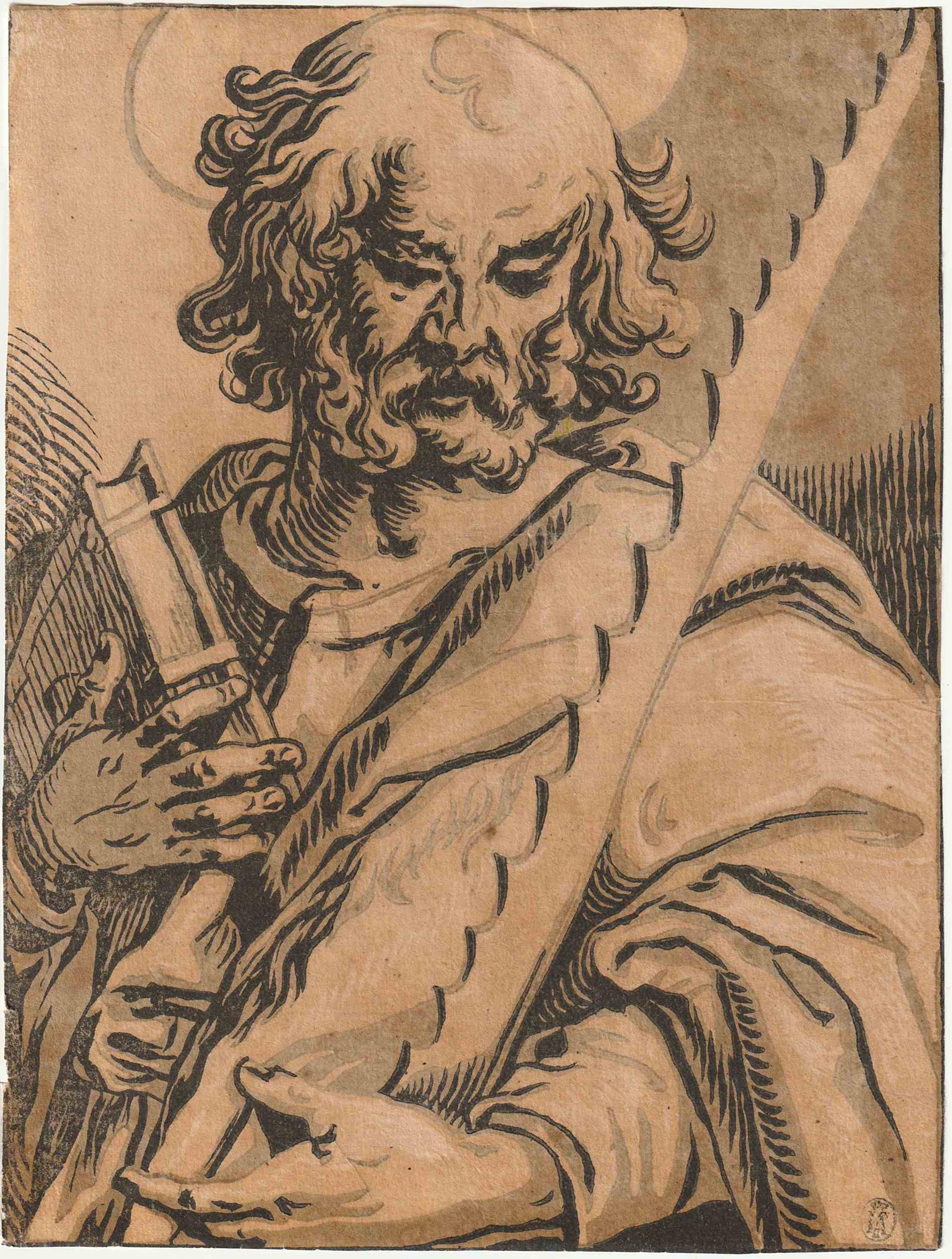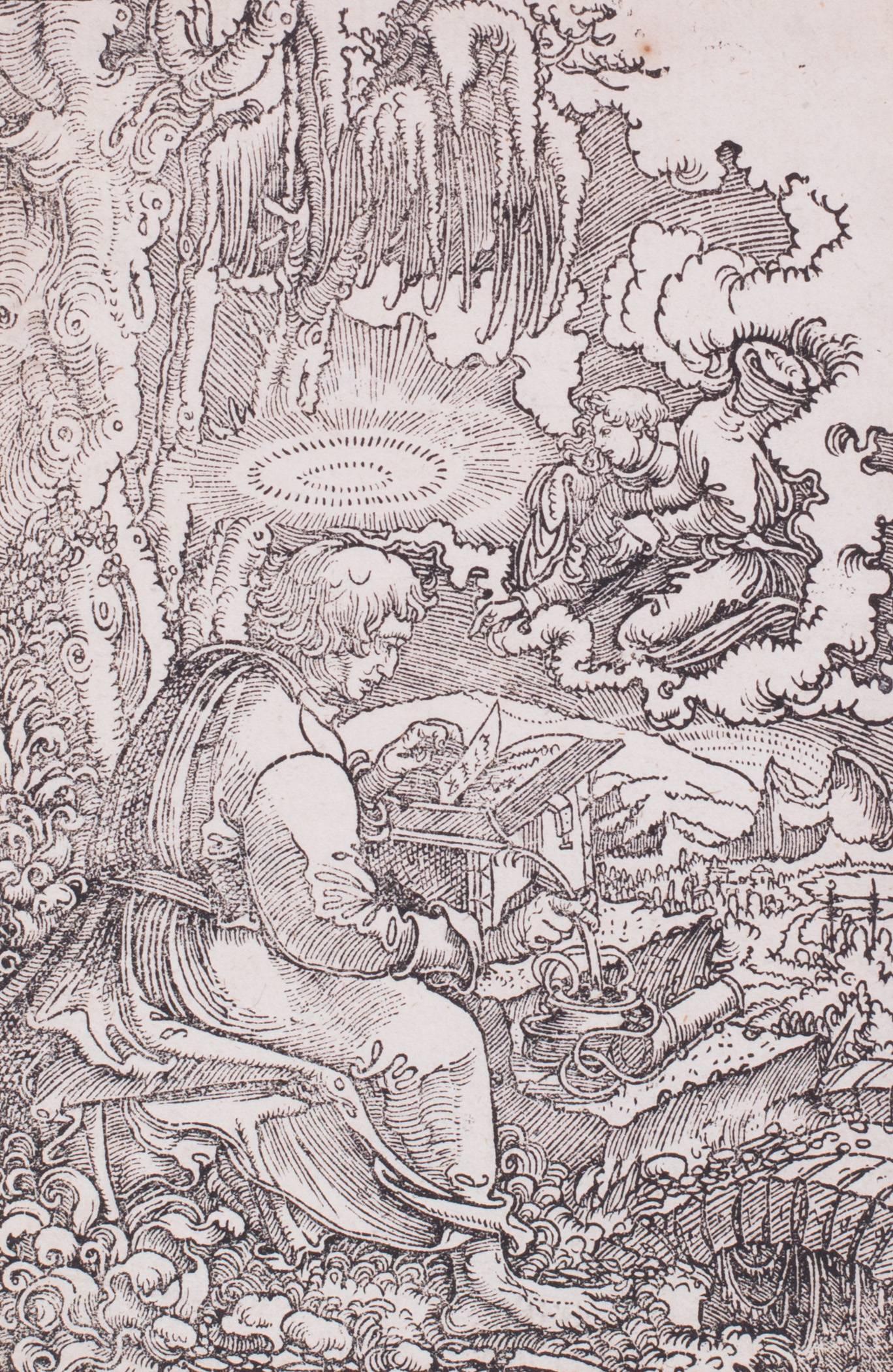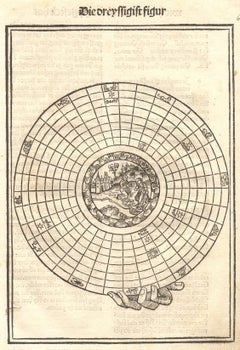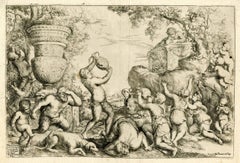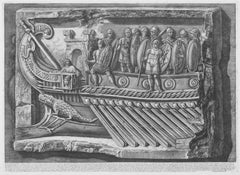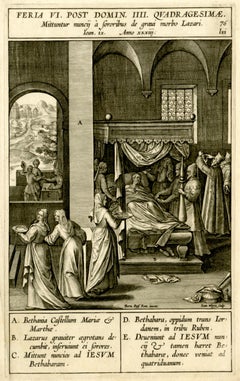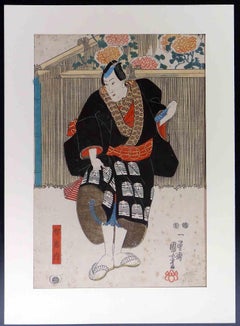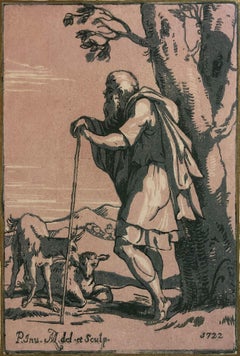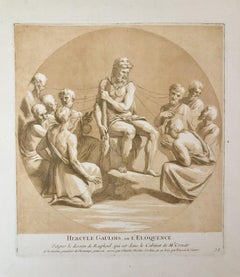Items Similar to The Garden of Love (after Peter Paul Rubens [1577-1640]
Want more images or videos?
Request additional images or videos from the seller
1 of 19
Christoffel JegherThe Garden of Love (after Peter Paul Rubens [1577-1640]c. 1633-1636
c. 1633-1636
About the Item
The Garden of Love (after Peter Paul Rubens [1577-1640])
Woodcut diptych, c. 1633-1636
Each of the two sheets is signed in the plate lower right
A posthumous impression with tiny worm whole in the block. Most proably late 17th century/early 18th century impression.
Extremely rare in any impressioon. The MMA impression is missing the right edge of the right sheet from top to bottom (see MMA catalog illustration).
A brilliant early impression was in the Laube Collection, Switzerland. That is the best impression that I have seen to date. Most impressions have condition issue like this pair of sheets.
The diptych is illustrated as the cover illustration for both the MMA Bulletin and the Courtald Collection Rubens catalog (see photos of both). It is discussed and illustrated in each catalog as well.
The composition is thought to be a number of of Rubens and hiw wife in various leisure activities.
Impressions are in the collection of the Metropolitan Museum of Art, Art Institute of Chicago, Philadelphia Museum of Art, Courtauld Gallery, London and the National Gallery of Art. The garden represents Paradise, but also fertility. This painting is an allegory and exaltation of love and marriage, as well as the merry company.
Provenance:
Swedish Royal Family
References And Exhibitions:
Fitzwilliam Museum, Rubens and Printmaking (Cambridge, England: Fitzwilliam Museum, 1990), nos. 36, 37, pp. 25-26, reproduced p. 26; detail reproduced in color on cover.
Courtauld Institute, Rubens Paintings, Drawings, Prints in the Princes Gate Collection Courtault Institute Galleries (London: University of London, 1988), no. 55, p. 48, reproduced; detail reproduced title page.
Mary L. Myers, "Rubens and the Woodcuts of Christoffel Jegher," The Metropolitan Museum of Art Bulletin XXV, Number I (Summer, 1966), pp. 7-23, reproduced pp. 18-19, figures 19-20.
F. W. H. Hollstein, Dutch and Flemish Etchings, Engravings and Woodcuts 1450-1700 (Amsterdam: , 1949-2003), 17 A&B.
"Having realized the potential profits to be made from reproductive prints of his work, Rubens began to engage printmakers from 1619 onward. In the early 1630s, he turned to woodcuts in close collaboration with Christoffel Jegher. Indeed, Jegher's place in art history as the most important woodcutter of his time rests exclusively on the nine large single-page woodcuts that resulted from this collaboration.
The Garden of Love is a variation of a picture by Rubens from the 1630s (Museo del Prado, Madrid). Two drawings by Rubens (finished by Jegher; see 58.96.1,.2) served as models. The woodcuts reproduce these drawings in reverse. The drawings, and consequently the prints, transform the composition of the painting into a frieze, most notably by dividing it into two separate parts, pushing the figures to the foreground and cropping the architecture at the top. The inherent nature of the coarse woodcut medium and the effect that could be achieved with it were fully exploited, particularly in the rendering of the human form." Courtesy MMA
"Christoffel Jegher produced several large-scale woodcuts in collaboration with the Flemish painter and diplomat Peter Paul Rubens, of which this two-sheet print is the largest. The panoramic garden setting includes delights such as a group of musical enthusiasts perched on plush chairs and colonnaded ledges on the left; on the right is a fountain grotto with decorative streams of water into which the most boisterous men try to cajole their lovers. The unsure woman on the far right, her waist firmly grasped by a smooth-talking admirer, resists the necessary push into temptation from a determined, winged Eros.
Rubens was deeply involved in producing prints after his paintings, of which the most illustrious were woodcuts created from about 1632 to 1636 by Christoffel Jegher. The most ambitious of these large woodcuts is the Garden of Love, a composition inspired by the painting of this subject (now at Waddeson Manor, Buckinghamshire), dated around 1630/31. Rather than an exact reproduction of the painting, the composition was redrawn with variations by Rubens on a separate sheet as a model for the woodcut artist to follow; it was then printed by Jeghers on two nearly equal-sized sheets that function as self-contained works. Belonging to the tradition of Medieval love gardens, the right half contains portraits of Rubens and his radiant young wife, Helena Fourment, who is echoed in almost all the female faces." Courtesy AIC
- Creator:Christoffel Jegher (1596-1652/3, Dutch)
- Creation Year:c. 1633-1636
- Dimensions:Height: 18.25 in (46.36 cm)Width: 23.25 in (59.06 cm)
- Medium:
- Movement & Style:
- Period:
- Condition:
- Gallery Location:Fairlawn, OH
- Reference Number:Seller: FA1849A-B1stDibs: LU14014716322
About the Seller
5.0
Recognized Seller
These prestigious sellers are industry leaders and represent the highest echelon for item quality and design.
Platinum Seller
Premium sellers with a 4.7+ rating and 24-hour response times
Established in 1978
1stDibs seller since 2013
784 sales on 1stDibs
Typical response time: 1 hour
Associations
International Fine Print Dealers Association
- ShippingRetrieving quote...Shipping from: Fairlawn, OH
- Return Policy
Authenticity Guarantee
In the unlikely event there’s an issue with an item’s authenticity, contact us within 1 year for a full refund. DetailsMoney-Back Guarantee
If your item is not as described, is damaged in transit, or does not arrive, contact us within 7 days for a full refund. Details24-Hour Cancellation
You have a 24-hour grace period in which to reconsider your purchase, with no questions asked.Vetted Professional Sellers
Our world-class sellers must adhere to strict standards for service and quality, maintaining the integrity of our listings.Price-Match Guarantee
If you find that a seller listed the same item for a lower price elsewhere, we’ll match it.Trusted Global Delivery
Our best-in-class carrier network provides specialized shipping options worldwide, including custom delivery.More From This Seller
View AllFather Stefan Fridolin, "Schatzbehalter" (Treasury of the True Riches
Located in Fairlawn, OH
Father Stefan Fridolin, "Schatzbehalter" (Treasury of the True Riches of Salvation): The 30th Figure - Astrological Diagram with Scene of the Nativity
Woodcut, 1491
Unsigned, as issued
Published by Anton Koberger
Diagram has Zodiac signs on outer ring, planets in the lower registers, and Nativity in the center.
Condition: Very good for a 15h century woodcut, with the usual slight age stains
Sheet size: 11 1/2 x 8 1/4 inches
Wogelmut was the teacher of Albrecht Durer and employed young Durer in many project of the last decade of the 15th century.
Michel Wolgemut Biography
Wolgemut trained with his father Valentin Wolgemut (who died in 1469 or 1470) and is thought to have been an assistant to Hans Pleydenwurff in Nuremberg. He worked with Gabriel Malesskircher in Munich early in 1471, leaving the city after unsuccessfully suing Malesskircher's daughter for breach of contract, claiming she had broken off their engagement. He then returned to his late father's workshop in Nuremberg, which his mother had maintained since Valentin's death.
In 1472 he married Pleydenwurff's widow and took over his workshop;[3] her son Wilhelm Pleydenwurff worked as an assistant, and from 1491 a partner, to Wolgemut. Some consider Wilhelm a finer artist than Wolgemut, however he died in January 1494, when he was probably still in his thirties. Wilhelm's oeuvre remains unclear, though works in various media have been attributed to him.
Woodcuts
Michael Wolgemut, Danse Macabre, 1493
Two large and copiously illustrated books have woodcuts supplied by Wolgemut and his stepson Wilhelm Pleydenwurff; both were printed and published by Germany's largest publisher, the Nuremberger Anton Koberger, who was also Dürer's godfather. The first is the Schatzbehalter der wahren Reichthumer des Heils (1491); the other is the Historia mundi, by Schedel (1493), usually known as the Nuremberg Chronicle...
Category
15th Century and Earlier Old Masters Figurative Prints
Materials
Woodcut
Bacchanal
By Giovanni Andrea Podestà
Located in Fairlawn, OH
Bacchanal
Etching, 1649
Inscribed in the square left: "Magnificentis/simo Principi/Paolo lorda/no. II Bracci/ani Duci/Aud. P.DDD/1640; Inscribed on right: Rome apud Franciscsum Saluucium
Condition: Usual centerfolds from paper manufacture
Plate: 10 3/8 x 15 1/2"
Sheet: 11 1/2 x 16 1/2";
References:
Bartsch XX.4
Sopher Plate 145
An impression of this image is in the collections of the Philadelphia Museum of Art and the National Gallery of Art, Washington
An exceptionally rich impression in excellent condition.
From Wikipedia, the free encyclopedia
Putti as Allegory of Music
Giovanni Andrea Podestà or Giovanni Andrea Podesta (1608 - c. 1674) was an Italian painter and engraver who was principally active in Rome. His principal subject matter is children playing in landscapes with classical objects. His works show the influence of Poussin's Arcadian landscapes and bacchanals, which were ultimately derived from Titian's bacchanals.
Life
Giovanni Andrea Podestà was born in Genoa. He was formed in Genoa with Giovanni Andrea de Ferrari and Domenico Fiasella according to the information provided by the contemporary Genoese biographer Raffaele Soprani. He is also recorded as an apprentice of Giovanni Battista Paggi in 1627.
His presence is documented from in 1634 in Rome where he made drawings after the statues and ancient reliefs at the famous Giustiniani collection. These were subsequently engraved for publication in the 'Galleria Giustiniani'. The artist's career ran a course similar to that of the young Domenico Fiasella. In Rome his art evolved in contact with the works of Poussin, Andrea di Leone, Pietro Testa...
Category
17th Century Old Masters Figurative Prints
Materials
Etching
Marble relief of a trireme from the Temple of Fortuna, Praeneste, from Vasi
By Giovanni Battista Piranesi
Located in Fairlawn, OH
Marble relief of a trireme from the Temple of Fortuna, Praeneste, from Vasi, candelabri, cippi, sarcofagi, tripodi, lucerne, ed ornamenti antichi disegnati ed incisi dal Cav. Gio. Ba...
Category
1770s Old Masters Figurative Prints
Materials
Etching
The Death of Lazarus
By Hieronymus Wierix
Located in Fairlawn, OH
The Death of Lazarus
Engraving, 1593
Feria VI. Post Domin IIII
From: Evangelicae Historiae Imagines, Plate 76
Condition: Excellent
Sheet size: 9 7/8 x 6 1/8 inches
Reference: Referen...
Category
16th Century Old Masters Figurative Prints
Materials
Engraving
Sextus Tarquinius Raping Lucretia
By Georg Pencz
Located in Fairlawn, OH
Sextus Tarquinius Raping Lucretia
Engraving, c. 1546-47
Signed with the intials in the plate (see photo)
From: "Four Scenes of Early Roman History"
An early impression with plate ton...
Category
16th Century Old Masters Figurative Prints
Materials
Engraving
Les deux tures coifffes d’un turban avec une aigrette (The turban with crest)
By Jacques Callot
Located in Fairlawn, OH
Les deux tures coifffes d’un turban avec une aigrette
(The two headdresses of a turban with a crest)
Etching, 1618
From: Varie Figure (16 plates)
Condition: Trimmed withing the plate...
Category
1610s Old Masters Figurative Prints
Materials
Etching
You May Also Like
Theater Actor in Black Coat on Stage- Woodcut by Utagawa Kunisada - 19th Century
By Utagawa Kunisada III
Located in Roma, IT
This figuration of a theater actor in a black coat on stage is the work of the Japanese artist Utagawa Kuniyoshi /1798-1861).
The brilliance of the colors, the graphic precision as ...
Category
19th Century Old Masters Figurative Prints
Materials
Woodcut
BATHOS / Tail PIece
By William Hogarth
Located in Santa Monica, CA
WILLIAM HOGRATH (1767- 1764)
THE BATHOS / Tail Piece 1764 (Paulson 1989: 216 I/I Paulson 1965/70: 216 I/I)
Engraving Plate 12 7/8 x 13 3/8, sheet 17 ¾ x 18 ¾ Designed & Engrav’d by Wm Hogarth at left and Published according to Act of Parliam’t March 3, 1764 at right. Good condition on thick laid paper Small bit of tape on the left & right sheet edges small stan lower sheet edge all on recto.
This Hogarth’s last print is fascinating as it is prophacy about death.
Various institutions have interesting commentaries - to wit:
Chicago Art Institute: Hogarth created The Bathos toward the end of his life. It is considered one of the bleakest artworks of the 18th century because it depicts the Apocalypse without an afterlife. The Angel of Death even collapses in exhaustion after having destroyed the world. In his hand is an execution decree and around him lies a mass of broken objects.
Princeton: Hogarth’s last print, The Bathos,….. is filled with all manner of images denoting the end of life as we know it. Entry no. 216 in Ronald Paulson’s catalogue raisonne Hogarth’s Graphic Works, 3rd revised edition says “This print is the culmination of such pessimistic images . . . . [taking] his general composition, the configuration of objects, and some of the particular items, from Dürer’s engraving, Melancholia; but he also recalls Salvator Rosa’s Democritus in Meditation (which derives from Dürer’s print) with a scroll at the bottom of the etching: ‘Democritus the mocker of all things, confounded by the ending of All Things’ (Antal, p.168).”
Newfields (Indianapolis Museum of Art): Hogarth intended this engraving to serve as the tailpiece to bound volumes of his collected engravings and, appropriately, it proved to be his last engraving. Father Time has died and his last will and testament has been witnessed by the three Fates. He is surrounded by a landscape of death, decay, and ruin. Hogarth aimed this print at dealers in “dark” Old Masters paintings who promoted the idea that ruins evoked sublime feelings in viewers—a sentiment, Hogarth wrote, that was reducing the world to ruin.
British Caricature...
Category
1760s Old Masters Figurative Prints
Materials
Woodcut
Elderly Shepherd Leaning on a Staff (after Parmigianino)
Located in Middletown, NY
A lovely chiaroscuro woodcut by Antonio Maria Zanetti the elder after a work by Parmigianino (Girolamo Francesco Maria Mazzola). Printed on cream laid paper, laid down to a cream lai...
Category
Early 18th Century Old Masters Figurative Prints
Materials
Laid Paper, Woodcut
Hercule Gaulois, ou L’Éloquence
By Charles-Nicolas II Cochin
Located in Middletown, NY
A classical chiaroscuro woodcut after Raphael executed by Charles Nicolas Cochin Père (1688-1754) & Vincent Le Sueur (1668-1743) . Printed from two bloc...
Category
Early 18th Century Old Masters Figurative Prints
Materials
Laid Paper, Woodcut
Saint Simon, from Christ and the Apostles
By Ludolf Ludwig Businck
Located in Middletown, NY
Chiaroscuro woodcut on cream laid paper, printed from three blocks in black, olive-green, and yellow ochre, 8 3/16 x 6 1/4 inches (207 x 157 mm), thread margins. Some scattered light discoloration throughout, lightly backed with laid paper, however the sheet retains translucence when viewed through raking light. Trimmed at or near the margin. Archivally sound small repaired corner tear, upper right, with a very minor (1/4 inch) vertical edge split in the center top margin, above the figure's head. All condition issues are consistent with age, and present an exceptionally good example of this truly remarkable work. With the collector's stamp of Friedrich August II, King of Saxony, last King of Poland (1797-1854), Dresden, on the right corner, recto (Lugt 971). This work likely appeared in a well-known posthumous sale of Friedrich August II's private collection, which was handled by C.G. Boerner, and took place in Leipzig, on May 7-9, 1928, presumably this print was presented as lot 1551.
[Stechow 16]
Ludolph Busïnck was born at Hann, Germany around 1590. By about 1620 he was actively working as a printmaker in Paris, collaborating with publisher and celebrated cartographer Melchoir Tavernier. Busïnck may have studied printmaking in the Netherlands, evidenced by the influence of Dutch printmaker Hendrick Goltzius we see in the bold woodcuts he produced in France. Busïnck was the first printmaker to create chiaroscuro woodcuts in France, a technique originated by German artist Hans Burgkmair...
Category
Early 17th Century Old Masters Portrait Prints
Materials
Woodcut
Matthew the Evangelist
By Georg Lemberger
Located in Petworth, West Sussex
Georg Lemberger (German, c. 1490 – 1540)
Matthew the Evangelist
Woodcut on paper
5.3/4 x 3.3/4in. (14.5 x 9.6 cm. )
Hollstein, 7. This is from the New German bible...
Category
16th Century Old Masters Figurative Prints
Materials
Woodcut
Recently Viewed
View AllMore Ways To Browse
Antique Love Chair
Frieze Drawing
P And P Chair Company
Antique Face Chair
18th Century Portrait Pair
1700 Antique Chairs
Antique Chairs 1700
Cambridge Chairs
Swedish Paintings 18th Century
18th Dutch Chairs
18th Century Dutch Chair
Wing Gate
Worm Chair
Chairs From 1700
Antique Chairs Chicago
P 31chairs
Rare Antique Water Fountains
Antique Grotto Chairs
